The story of the St. Antonio Hospital, Izmir - Linda Tito, 2012 |
|
The St. Antonio Hospital was founded Italian Franciscan monks in 1866 and in French monks of the order of the ‘Famille Saint Vincent’ who were active at the time Izmir were invited to run the institution.
In 1900 the local architect, Raymond Peré created a set of drawing of the variety of institutions in and around Smyrna run by the ‘Famille Saint Vincent’, and these drawings have been displayed for many years at the St. Polycarpe Church Hall in Alsancak.
The clues of the location of the St. Antoine Hospital are in the destroyed remains of it photographed shortly after the 1922 fire and clearly marked as such. With the observation of the historian Okan Çetin recently it is clear there is a tower visible on the right of this picture and comparing with the drawing of the Hospital by Peré the tower can be identified. With the help of another historian, Yaşar Ürük, they were able to place the location of this hospital around Şehit Nevres Boulevard.
However as stated in this site within the interview of the British Consul Willie Buttigieg, the former British Seaman’s Hospital in Alsancak was used between the two World Wars as the St. Antonio Hospital. The elders in our Levantine community have confirmed this information that the building now serving as the Tourism School was this building.
I was able to confirm this information with the local priest Alpaslan Balcıer, who remembered recollections of his fellow priest P. Sebastiano Bossina who had lived in the city since 1935 and who died in 1985. Further confirmations came from elderly friends and relations that this building was indeed the site of the St. Antonio Hospital, not too far from Alsancak train station.
So to recap, the St. Antonio Hospital between 1866 and 1922 was near the present Cathedral of St. John. After the fire the ‘Saint Vincent de Paul’ priests left the town and in 1927 the Italian Sisters under the order of ‘Suore dell’Immacolata di Ivrea’ (who still run the Italian School today) operated the hospital. They operated this hospital at the site of the former British Hospital till 1945 or thereabouts. At the time Italy was without a functioning government and the sisters were left without support. At the time both this hospital and the ‘Centrale’ School were closed, the latter with the stated reason of widening the road. The sisters then opened the current school.
To confirm this story, I also found a written document entitled: “Le Suore dell’Immacolata Concezione di Ivrea a Smirne 50.mo anno di loro apostolato” (1887 – 1937 ) Lbr. Ed. “Frate Francesco” Parma. This book [large file!] was produced in 1937 on the occasion of the 50th anniversary of the presence of the Italian nuns in Izmir. The booklet states clearly that the St. Antonio Hospital continued its activities first as a camp hospital before moving to the former British Hospital buildings in 1927.
In a 1935 dated letter by a Franciscan priest the following are written:
Straight after the Fire, so as not to lose the rights to run a hospital, a camp hospital was established to run in conjunction with the Italian Red Cross. At the same time investigations were started as to where they could move to and after 2 changes (?), the old British Military [in reality Seaman’s] Hospital was chosen. An agreement was reached for an annual rent in the region of three to four thousand Turkish liras.
The portion of the records of the Dominican priests leaves no doubt that the temporary camp hospital of St. Antonio was set up next to their church. A section of the writings of the head priest of the time Giordano Grosso:
On the 2nd of October on the square opposite our monastery, a large camp hospital of the Italian Red Cross was established. It had a bed capacity of 200, was managed by Dr. Ernesto Basso, which included in its staff famous doctors and surgeons, assisted by Italian nuns (of the order of Sr. di Carità). This was a good demonstration of Italian compassion. Under wide tents patients were accepted from every nation and religion. Wounded Turks were in the majority, we visited them frequently and exchanged pleasantries. After so many problems, pain and events our spirits are lifted and we are hopeful for better days to come.
One final mystery is the marking on some maps (view Goad 1905 fire insurance map section) of the St. Antonio Hospital as the Austrian Hospital. This was explained in the book this way: St. Antonio Hospital was attached to the St. Maria Church that was an Italian Church under the control of Franciscan friars, yet was under the protection of the Hapsburg Empire till the end of the First World War. So it was known at the time as the Austrian Hospital even though it was staffed by Italians.
Sources consulted:
…Le tremblement de terre du 10 juillet 1688 détruisit l’Eglise et le couvent des pp. récollets et presque tous les Pères furent brulés vifs. Ceux qui furent sauvés, mieux conseillés, et pour éviter les avanies des Grecs, achetèrent le terrain sur lequel s’élevé aujourd`hui l’hôpital de St. Antoine, y bâtirent un couvent et une église, en 1691, sous le vocable de St. Antoine de Padoue. L’air était mauvais à cet endroit et en 1696 ils bâtirent leur couvent près de la mer. Mais en 1698 l église et le couvent de St. Antoine furent brulés…
Smyrne – 1880 (Charles de SCHERZER) - cover
Etablissement vaste, aéré, très bien entretenue, fondé par la communauté catholique avec le produit de souscriptions recueillies principalement en Autriche-Hongrie, est placé sous le protectorat austro-hongrois. Les malades indigènes catholique y sont admis gratuitement; les marins de la flotte et les malades non catholiques contre paient 7 piastres par jour. Une confrérie dont tout catholique peur devenir membre moyennant une cotisation annuelle de 1 livre turque, subvient aux dépenses de l`hôpital et nomme à l’élection un comité de douze personnes dont les deux (prieurs)administrent l’hôpital.
L’établissement conte 100 lits de malades, d’incurables et d’aliénées. Le traitement de ces derniers laisse, comme à l’hôpital grec, beaucoup désirer. Le mouvement annuel des entrées est de 300 à 400.
Les recettes ordinaires atteignent 500, les dépenses 1650 livres turques annuellement. Le déficit est couvert de la même manière que pour l’hôpital grec.
Smyrne - 1892 (Firmin ROUGON) - segment
L’Hôpital catholique St. Antoine est administré par un comité de laïques, choisie parmi les notables catholiques de toute nationalité. Sa fondation remonte vers l’année 1710. Les malades y sont reçus sans distinction de religion et de nationalité; les marins et les malades non catholiques paient 7 piastres par jour. Les infirmes disposant de ressources personnelles sont également acceptés moyennant une rétribution… L’établissement est desservi par les sœurs de la Charité.
Le diocèse de Smyrne -1908 (Abbé Frank de PORTU) - cover
L’Hôpital catholique St. Antoine, fondé vers 1710, est desservi par les sœurs de Charité sous la protection de l’Autriche, depuis 1865-1866.
Saint Polycarpe et son tombeau sur le Pagus - 1911 (Père Jean Baptiste de Smyrne) - segment
L’Eglise de l’Hôpital autrichien de St. Antoine, établissement tenu par les Filles de la Charité.
1935 letter
From the Francescan Mission / priests who were running the St. Antonio Hospital sent to the ambassador of the Italian King thanking him for the help he gave to the Mission and also giving details of the Mission and origins of the hospital of St. Antonio. - view as a pdf -
Click to view images of this hospital - as depicted in Péré drawings in 1900
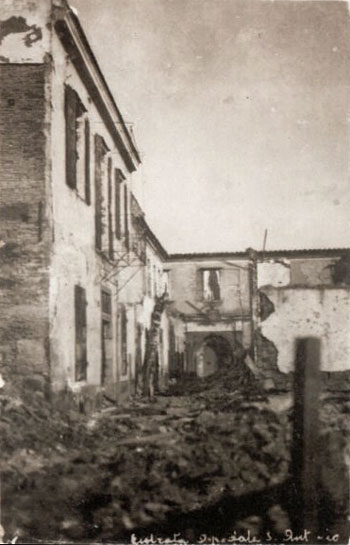 |
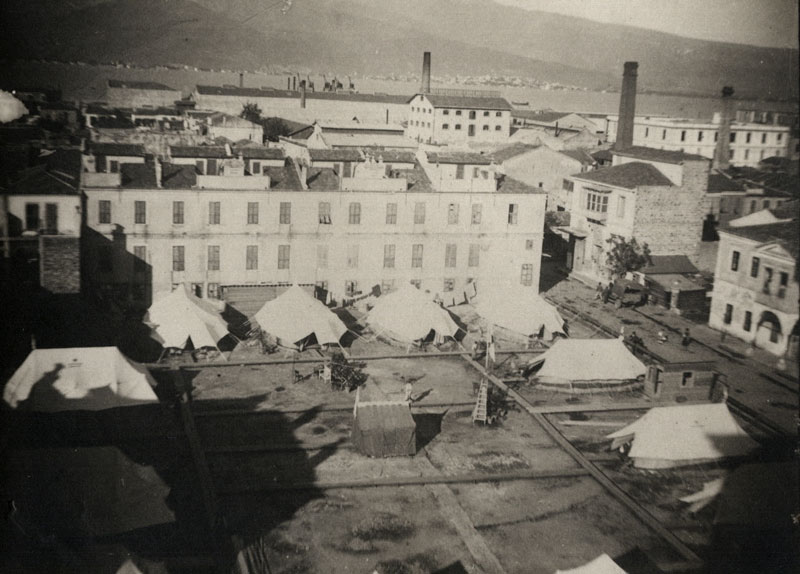 |
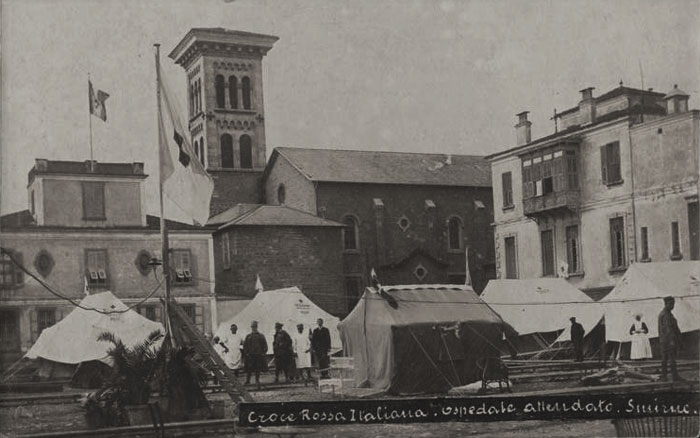 |
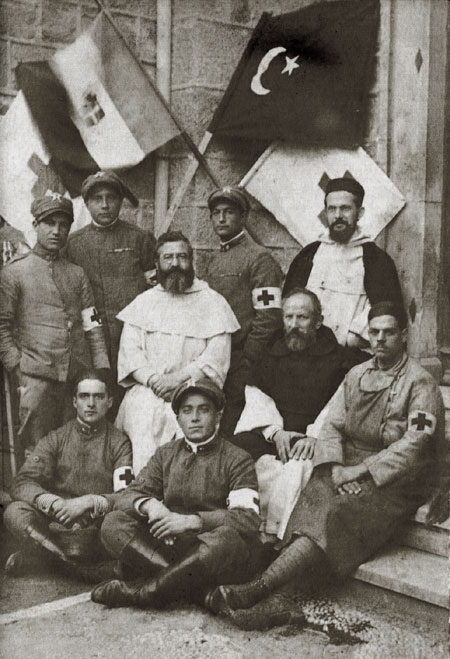 |
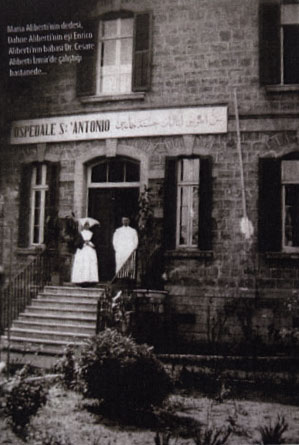 |
